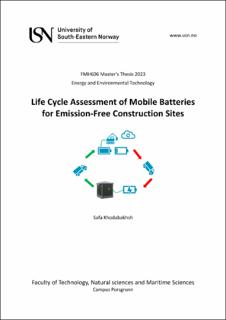| dc.description.abstract | Nowadays, due to increasing demand for energy and limited availability, there has been an increased focus on developing emission-free construction sites. To address this issue, life cycle assessment (LCA) is used as a useful tool in different fields to assess energy requirements and emissions throughout the life cycle of products.
The objective of this study is to present LCA for Skagerak battery, with a focus on the Global Warming Potential (GWP) as an impact category. In order to supply energy to construction equipment, the project involves transporting fully charged batteries from a charging station to the construction site. When the batteries are depleted, fully charged batteries are transported by a truck to replace them. For this pilot project, Skagerak Energi is providing two charging platforms, one bidirectional platform, and four mobile battery containers totaling 576 kWh, all using CCS type 2 charging cables.
In the production phase, the study estimates the GWP and energy consumption related to battery production based on information from different research papers, and then the GWP of transportation to the Skagerak company by using Skagerak’s data is presented. NMC 111 is used as the mobile battery in this project, so the relevant literature is reviewed to provide an overview of the production step for this battery.
This study’s next step is estimating the energy loss due to energy conversion and transportation required for charging the battery. The GWP for these steps is presented. Skagerak uses biogas for transportation in order to charge the battery; the GWP of different biogases is presented, and then the differences between diesel and biogas are covered. The specification of the Samsung SDI battery has been used to estimate energy loss for the battery used on the construction site. | |
